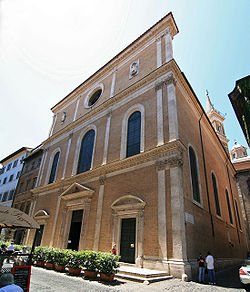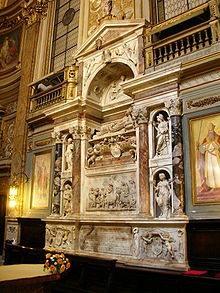- Santa Maria dell'Anima
-
Santa Maria dell'Anima
Our Lady of the Soul (English)
Façade of the church.
Basic information Location  Rome
RomeGeographic coordinates 41°53′59.1″N 12°28′19.3″E / 41.89975°N 12.472028°ECoordinates: 41°53′59.1″N 12°28′19.3″E / 41.89975°N 12.472028°E Affiliation Roman Catholic Year consecrated 1542 Ecclesiastical or organizational status National Church in Rome of Germany Leadership Don Franz Xaver Brandmayr Website www.santa-maria-anima.it Architectural description Architect(s) Andrea Sansovino, Giuliano da Sangallo Architectural type Church Architectural style hall church Direction of façade E Groundbreaking 1386 Completed 1522 Specifications Length 40 metres (130 ft) Width 30 metres (98 ft) Santa Maria dell'Anima (English: Our Lady of the Soul) is a Roman Catholic church in central Rome, Italy, just west of the Piazza Navona and near the Santa Maria della Pace church. It was the national church of the Holy Roman Empire in Rome. The church is today the national church of Germany and hospice of German-speaking people in Rome.
According to tradition, the church received its name, from the picture of Our Lady which forms its coat of arms (the Blessed Virgin between two souls).[1] Among the artworks housed inside is the Holy Family by Giulio Romano. It is the resting place of the Dutch Pope Adrian VI as well as of Cardinals William of Enckenvoirt and Andrew of Austria.
Contents
History
14th and 15th century
Santa Maria dell'Anima is one of the many medieval charity institutions built for pilgrims in Rome. The church found its origin in 1350, when Johannes (Jan) and Katharina Peters of Dordrecht bought three houses and turned it into a a private hospice for pilgrims, at the occasion of the Jubilee of 1350.[2] Jan Peters may have been a Dutch merchant or papal soldier. They named the hospice "Beatae Mariae Animarum" ("Saint Mary of the Souls").[3] It was erected on its present site in 1386. In the 15th century Santa Maria dell'Anima expanded to be a hostel for visitors from the entire Holy Roman Empire, though initially the occupants were primarily from the Low Countries and (from the middle 15th century) the Rhineland.
The foundation of the hospice was confirmed by the bull of Pope Boniface IX on 9 November 1399, which granted it indulgences.[3] In 1406, it was raised to the rank of a national institution and united with a Brotherhood governed by Provisors and a Congregation. On May 21, 1406 Pope Innocent VII in his bull Piae Postulatio declared the hospice exempted it from all but papal jurisdiction, and took it under his immediate protection. In 1418, it was greatly enriched by the legacy of its second founder, Diedrich of Niem.
The Popes of the fifteenth century, with the exception of Pope Sixtus IV, showed it great favor. In 1431 a church was built on the place of the hospice's chapel (consecrated by Pope Eugene IV in 1444) and the community was united with the German hospice of St. Andrew which had been founded in 1372 by the priest Nicholas of Kulm. During the fifteenth and sixteenth centuries Santa Maria dell'Anima became the national and religious centre as well as burial place in Rome of the Holy Roman Empire.
16th-17th century
Johann Burchard from Strasbourg joined the Confraternity of Santa Maria dell'Anima and rose to be its provost at the end of the 15th century. While he held this office, the decision was made to rebuild the church for the Jubilee of 1500. The present church which owes its Renaissance style to the influence of Bramante, was built by German subscriptions, between 1499 and 1522. It stands on the site of the older church, built between 1431 and 1499, and was decorated by the great artists of the period.
The church was built in the style of a hall church that was typical for Northern Europe, but which sits awkwardly amid the Italianate churches of Rome. Andrea Sansovino was retained as architect. The facade was completed by Giuliano da Sangallo. The new church was consecrated only on Nov 25 1542.
18th-20th century
During the Napoleonic occupation, the church was plundered and the sacristy used as a horse stable. In 1844, the (new) Belgian community moved to the Church of St. Julian of the Flemings. In 1859, under the influence of the era's nationalism, the Confraternity was transformed to a German seminary and renamed the Collegio Teutonico di Santa Maria dell'Anima. Dutch Catholics retained the Anima as their national church, but after extended conflicts left it in 1939 (since 1992 the San Michele dei Frisoni near the Vatican has taken that role).
Interior
Among the artistic treasures of the church are (in chronological order):
- A altarpiece painted by Giulio Romano in 1521-22 for a Fugger family, depicting the Sacred Family and donors (Mark and Giacomo Fugger).
- The funeral monument of Pope Adrian VI (1459–1523), commissioned by his friend, cardinal Willem van Enckevoirt and designed in part by Baldassarre Peruzzi.
- An altarpiece (1532) by Lorenzetto.
- The funeral monument of Willem van Enckevoirt (1464–1534), bishop of Tortosa (1522–1534) and of Utrecht (1529–1534). The monument by Giovanni Mangoni was originally located next to Adrian's monument, but was moved to near the main entrance in 1575.
- A Deposition (1550) by Francesco Salviati
- A painting by Girolamo Siciolante da Sermoneta.
- The funeral monument of Andrew of Austria (1558–1600), cardinal since 1573
- Miracles of Saint Benno and Martyrdom of Saint Lambert (1618) painted by Carlo Saraceni.
An internal courtyard houses some ancient findings.
Notes
- ^
 Schmidlin, J. (1913). "College and Church of the Anima (in Rome)". Catholic Encyclopedia. New York: Robert Appleton Company.
Schmidlin, J. (1913). "College and Church of the Anima (in Rome)". Catholic Encyclopedia. New York: Robert Appleton Company. - ^ Baumüller 2000, pp. 11
- ^ a b Michaud 2006, pp. 26
Sources
- Baumüller, Barbara (2000) (in German). Santa Maria dell'Anima in Rom: ein Kirchenbau im politischen Spannungsfeld der Zeit um 1500. Gebr. Mann. ISBN 9783786123088.
- Michaud, Cécile (2006). "Santa Maria dell'Anima" (in French). Johann Heinrich Schönfeld: un peintre allemand du XVIIe siècle en Italie. Martin Meidenbauer Verlag. pp. 26–27. ISBN 9783899755855. http://books.google.be/books?id=pdV2TPvknK0C&pg=PA26.
- Clifford W Maas and Peter Herde, The German Community in Renaissance Rome, 1378-1523, Rome: Herder, 1981. ISBN 3451191490 9783451191497
This article contains public domain text from the article
 Schmidlin, J. (1913). "College and Church of the Anima (in Rome)". Catholic Encyclopedia. New York: Robert Appleton Company.
Schmidlin, J. (1913). "College and Church of the Anima (in Rome)". Catholic Encyclopedia. New York: Robert Appleton Company.External links
- Official website
- Official website of the vicariate of Rome
- History of the church on the German community in Rome's website (German)
- S. Maria dell'Anima (Dutch)
Categories:- Roman Catholic churches in Rome
- 14th-century church buildings
- Burial places of popes
- National churches in Rome
- Renaissance architecture in Rome
Wikimedia Foundation. 2010.


